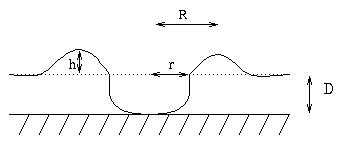
| MadSci Network: Physics |
If you want to get picky about it, the answer is "infinitely high." A large meteorite crash can be big enough to blast blobs of water clear into orbit, or cause them to leave Earth entirely. But that's not really a "tidal wave".
This is a question that's really hard to answer exactly. Let's get a rough idea of the answer by using order of magnitude estimation. With this technique, we care only about the rough answer, and ignore factors of 2 or 3.
A large asteroid hitting the ocean will blast a "crater" in the ocean of radius r; a big one ("end-of-the-world") might remove all the water clear to the ocean floor at depth h. Some of that water will be vaporized or blasted clear of Earth, but let's suppose most of it piles up next to the crater, as shown in the figure below.

Now, the "crater" will quickly fill in with water, and the nearby pile will collapse. This will make tidal waves which propagate to the right and left. The volume excavated by the crater is roughly
v_crater = pi r^2 Dwhere we've assumed a roughly cylindrical volume of water is blasted out. This water forms a ring-shaped hill surrounding the crater: this ring will propagate away from the impact site. Its width will be roughly the same as the crater width r (you can see this by dropping rocks into a pond), and its radius will be roughly R. R increases as the ring moves outward, but r stays constant. The volume of water in the ring-shaped hill is
v_ring = circumference * height * width = 2 pi R h rThis is the same volume as the crater:
v_ring = v_crater 2 pi R h r = pi r^2 D h = (r D)/RThe tidal wave can be as high as the ocean is deep, when the impact first occurs (and R and r are nearly the same.) The ocean is on average 5 kilometers deep. But as the ring moves out, the wave gets less high. This, too, is apparent from watching ripples on a pond from a dropped stone.
According to the formulas in The SEDS space calculations FAQ, an asteroid hitting with the energy of 40 million Hiroshima a-bombs (an event which might happen once every 250,000 years) would make a crater 13 kilometers across. Your average ocean basin is 10,000 kilometers across, so the expanding ring might be 7 meters high when it hit a continent, assuming it hit near the middle of the ocean. Keep in mind that tidal waves get much taller and steeper when they hit a shoreline: a typical earthquake-generated tidal wave 2 meters high in deep ocean can become a 30-meter-high wall of water when it hits the shore. So our 7-meter high asteroid-made tidal wave could become 100 meters high!
Thanks for asking such an interesting question. Doing back-of-the-envelope calculations like this is lots of fun. For more information on the destructiveness of asteroid strikes, see The Nine Planets website.
Try the links in the MadSci Library for more information on Physics.